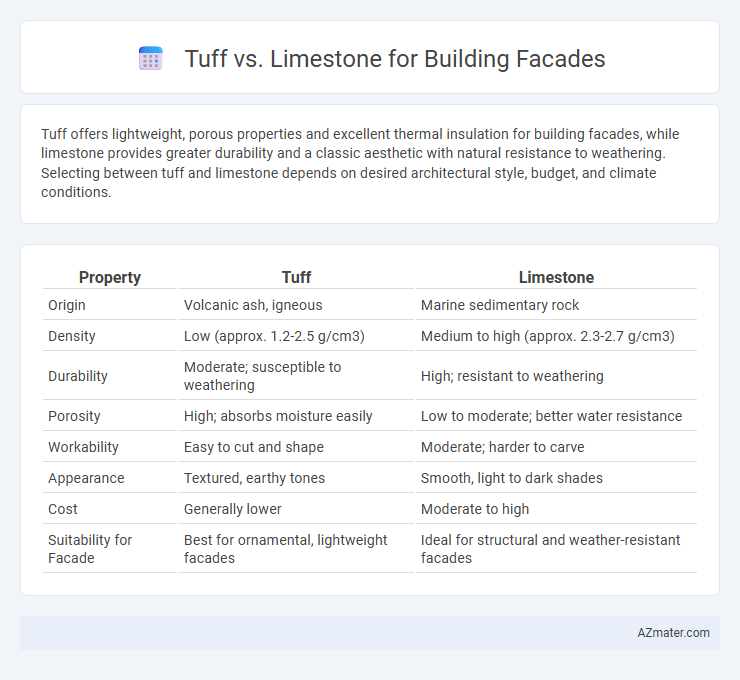Tuff offers lightweight, porous properties and excellent thermal insulation for building facades, while limestone provides greater durability and a classic aesthetic with natural resistance to weathering. Selecting between tuff and limestone depends on desired architectural style, budget, and climate conditions.
Table of Comparison
| Property | Tuff | Limestone |
|---|---|---|
| Origin | Volcanic ash, igneous | Marine sedimentary rock |
| Density | Low (approx. 1.2-2.5 g/cm3) | Medium to high (approx. 2.3-2.7 g/cm3) |
| Durability | Moderate; susceptible to weathering | High; resistant to weathering |
| Porosity | High; absorbs moisture easily | Low to moderate; better water resistance |
| Workability | Easy to cut and shape | Moderate; harder to carve |
| Appearance | Textured, earthy tones | Smooth, light to dark shades |
| Cost | Generally lower | Moderate to high |
| Suitability for Facade | Best for ornamental, lightweight facades | Ideal for structural and weather-resistant facades |
Introduction: Comparing Tuff and Limestone for Facades
Tuff and limestone are popular natural stones used for building facades, each offering distinct aesthetic and structural qualities. Tuff, a volcanic rock, is lightweight and porous, providing excellent insulation and a unique texture that weathers well over time. Limestone, a sedimentary rock, is denser and more durable, prized for its smooth finish and ability to withstand harsh weather conditions while maintaining a classic architectural appearance.
Geological Origin of Tuff and Limestone
Tuff originates from volcanic ash ejected during explosive volcanic eruptions, which then compacts and solidifies into a soft, porous rock ideal for lightweight and insulating building facades. Limestone forms through the accumulation and compression of marine skeletal fragments such as coral and shell over millions of years, producing a dense, durable sedimentary rock commonly used for its strength and aesthetic appeal. The distinct geological origins of tuff's igneous volcanic nature and limestone's sedimentary marine formation influence their physical properties, durability, and suitability for different architectural facade applications.
Physical Properties Overview
Tuff is a volcanic rock characterized by its lightweight and porous nature, offering good insulation properties and ease of cutting for intricate designs. Limestone, a sedimentary rock, is denser and harder, providing greater durability and resistance to weathering but can be more challenging to work with due to its weight. Both materials have unique thermal conductivity and compressive strength values influencing their suitability for building facades in different environmental conditions.
Durability and Weather Resistance
Tuff exhibits high durability and exceptional weather resistance due to its volcanic origin, making it less prone to erosion and cracking compared to limestone. Limestone, while aesthetically versatile, is more susceptible to acid rain and freeze-thaw cycles, which can degrade its surface over time. Selecting tuff for building facades ensures longer-lasting structural integrity in harsh environmental conditions.
Aesthetic Appeal and Color Variations
Tuff offers a unique aesthetic appeal with its porous texture and warm earth tones ranging from soft yellows to deep browns, creating a rustic yet elegant facade option ideal for Mediterranean and contemporary designs. Limestone provides a smooth, fine-grained surface with a broader color palette including creamy whites, beiges, and subtle grays that enhance brightness and sophistication in both classical and modern architectural styles. The choice between Tuff and Limestone significantly influences facade character, as Tuff's natural ruggedness contrasts with Limestone's polished refinement, allowing for tailored aesthetic and color preferences in building exteriors.
Workability and Construction Techniques
Tuff offers superior workability for building facades due to its lightweight and easy-to-cut nature, allowing for intricate designs and faster installation compared to denser limestone. Limestone requires specialized tools and more labor-intensive techniques because of its hardness and brittleness, often resulting in longer construction times and higher costs. Both materials demand skilled masonry, but tuff's properties facilitate efficient handling and flexibility in construction methods, making it advantageous for detailed facade work.
Sustainability and Environmental Impact
Tuff, a volcanic rock, offers superior insulation properties and natural durability that reduce energy consumption in building facades, making it a sustainable choice compared to limestone. Limestone extraction often involves significant quarrying and processing that result in higher carbon emissions and habitat disruption, whereas tuff's lower density and local availability can minimize transportation-related environmental impacts. The porous structure of tuff also allows better air quality regulation and moisture control, enhancing overall building sustainability while reducing long-term maintenance needs.
Cost Analysis and Availability
Tuff offers a cost-effective building facade option due to its natural abundance and ease of quarrying, resulting in lower transportation and material expenses compared to limestone. Limestone, while often pricier due to its widespread demand and quarrying complexity, provides superior durability and aesthetic versatility that may justify the higher upfront costs in long-term investment. Regional availability heavily influences the price difference; tuff is more accessible and economical in volcanic areas, whereas limestone dominates markets where sedimentary rock deposits are prevalent.
Maintenance Requirements Over Time
Tuff is a porous volcanic rock that requires regular sealing and cleaning to prevent weathering and moss growth, ensuring long-term durability for building facades. Limestone, while denser, is susceptible to acid rain and pollutants, leading to gradual surface erosion that necessitates periodic restoration and protective coatings. Both materials demand ongoing maintenance, but tuff generally needs more frequent attention due to its higher porosity and vulnerability to environmental factors.
Best Applications: Choosing the Right Stone for Your Facade
Tuff is ideal for facades requiring lightweight, porous stone with excellent thermal insulation, making it suitable for Mediterranean and volcanic regions. Limestone offers durability and a classic aesthetic with its dense structure, making it perfect for historic restorations and urban buildings exposed to harsh weather. Selecting the right stone depends on environmental conditions, structural needs, and desired visual appeal to ensure longevity and performance.

Infographic: Tuff vs Limestone for Building Facade
 azmater.com
azmater.com